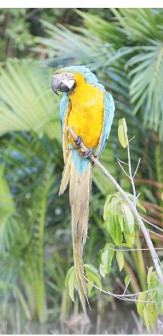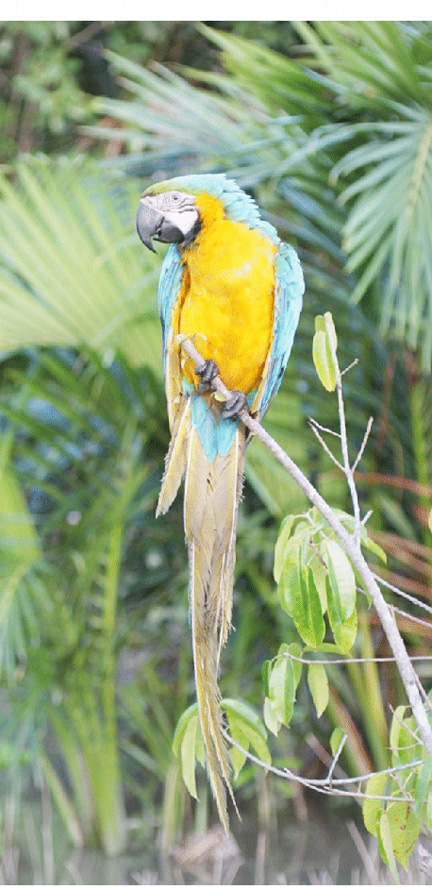Macaws are large, dramatic birds, of the Psittacidae family which also includes parrots. Macaws are easily recognisable by their long wings and long tails as they fly overhead with strong steady wing beats.
The Blue and Yellow Macaw (Ara Ararauna) is between 75-87 cm in height, a rich blue colour on the upper parts, a green forehead and yellow belly, flanks and under wing and tail coverts, it is easily recognized by its call and colour when in flight.
Blue and Yellow Macaws inhabit mangroves, boggy stands of Mauritia (Ite) palm and lowland and gallery forests. They are often seen flying in pairs or a few pairs together, flying one behind the other in a diagonal line, with the female(s) slightly ahead as they commute from their roost to feeding grounds. They feed silently on fruits and nuts in the canopy and during the heat of the day, fly to cool, shady boughs of canopy trees for a siesta, often making a raucous “raaaak” call when en route.
Macaws will often gather in large numbers at fruiting palm and mango trees. Fair View Village near Kurupukari has a conservation area of Ite palm trees to ensure that the Blue and Yellow Macaws will always return to that village when the fruits are in season.
Macaws generally mate for life and lay 2 to 3 eggs in a hollow tree. The first youngster will fledge 13 weeks after hatching and after fledging the first young, the parents stop visiting the nest. If there is a third chick and it is too small to fledge, it will often die of starvation and neglect.

Rain forests are rich in biodiversity and are home to many different plants and animals as well as indigenous communities.
Humans, even those who don’t live in the rain forest, rely on it for resources such as building materials (wood and lianas), medicine and fruits.
Rain forests also provide essential environmental services for life on earth; they create soil as well as prevent soil erosion, produce oxygen through photosynthesis, maintain clean water systems, and are a key defence against climate change.
The Iwokrama Rain Forest is 371,000 hectares, located in the heart of Guyana. Our mission is to develop strategies for conservation and sustainable development for local people in Guyana and the world at large.
We are involved in timber, tourism and training. Come and visit us in the rain forest or at http://www .iwokrama.org.

